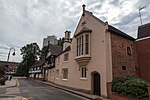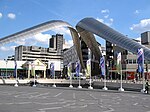Coventry ( (listen) KOV-ən-tree or KUV-) is a city in the West Midlands, England. It is on the River Sherbourne. Coventry has been a large settlement for centuries, although it was not founded and given its city status until the Middle Ages. The city is governed by Coventry City Council.
Formerly part of Warwickshire until 1451, Coventry had a population of 345,328 at the 2021 census, making it the tenth largest city in England and the 12th largest in the United Kingdom.It is the second largest city in the West Midlands region, after Birmingham, from which it is separated by an area of green belt known as the Meriden Gap, and the third largest in the wider Midlands after Birmingham and Leicester. The city is part of a larger conurbation known as the Coventry and Bedworth Urban Area, which in 2021 had a population of 389,603.Coventry is 18 miles (29 km) east-south-east of Birmingham, 24 miles (39 km) south-west of Leicester, 10 miles (16 km) north of Warwick and 94 miles (151 km) north-west of London. Coventry is also the most central city in England, being only 12 miles (19 km) south-west of the country's geographical centre in Leicestershire.Coventry became an important and wealthy city of national importance during the Middle Ages. Later it became an important industrial centre, becoming home to a large bicycle industry in the 19th century, in the 20th century it became a major centre of the British motor industry, this made it a target for German air raids during the Second World War, and in November 1940, much of the historic city centre was destroyed by a large air raid.
The city was rebuilt after the war, and the motor industry thrived until the mid-1970s, although by the late-1970s/early-1980s Coventry was in an economic crisis and amongst the country's highest levels of unemployment due to major plant closures and the collapse of the respective local supply-chain. In recent years Coventry has seen regeneration and an increase in population. The city has three universities: Coventry University in the city centre, the University of Warwick on the southern outskirts and the smaller private Arden University with its headquarters close to Coventry Airport.
Coventry was awarded UK City of Culture for 2021.












